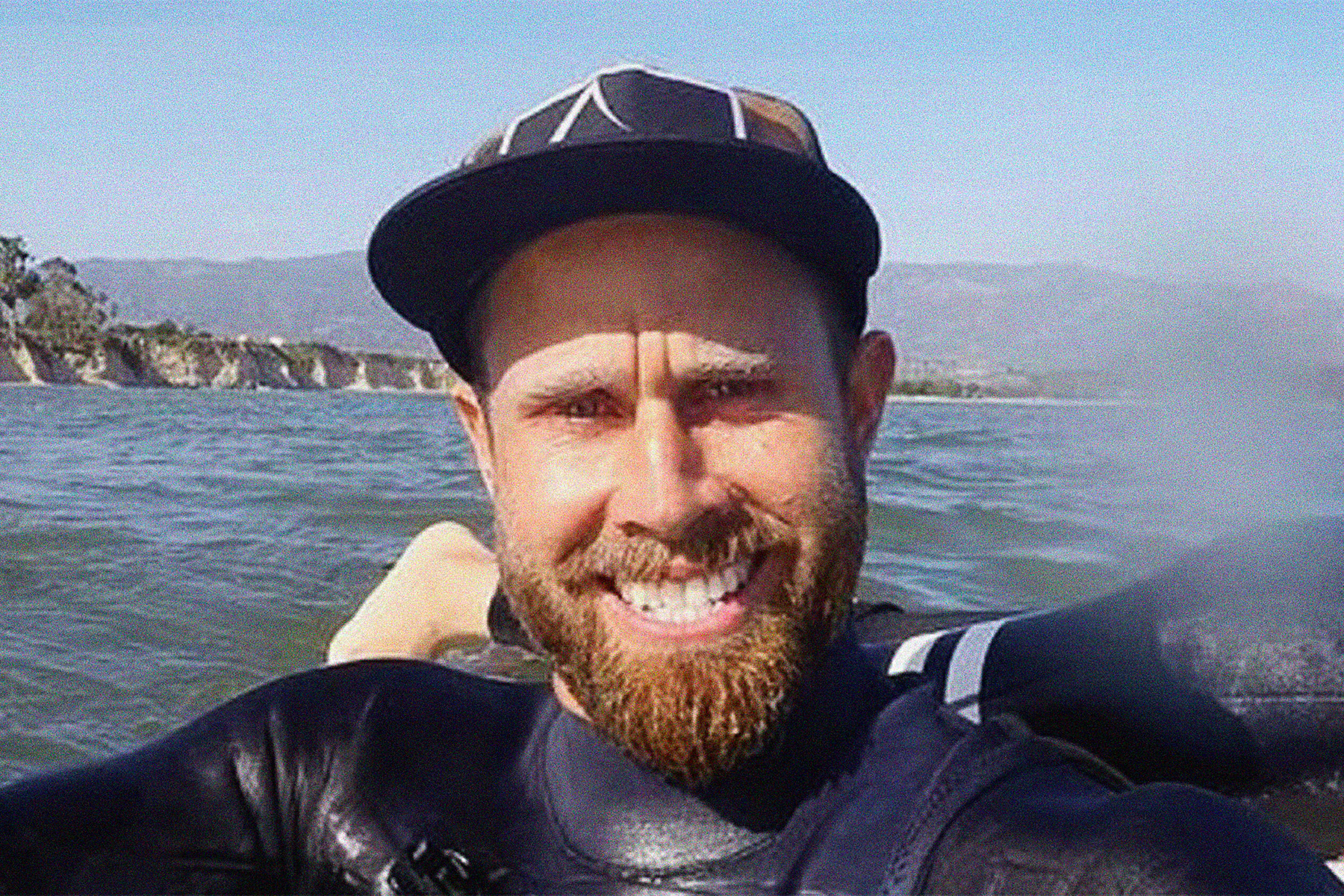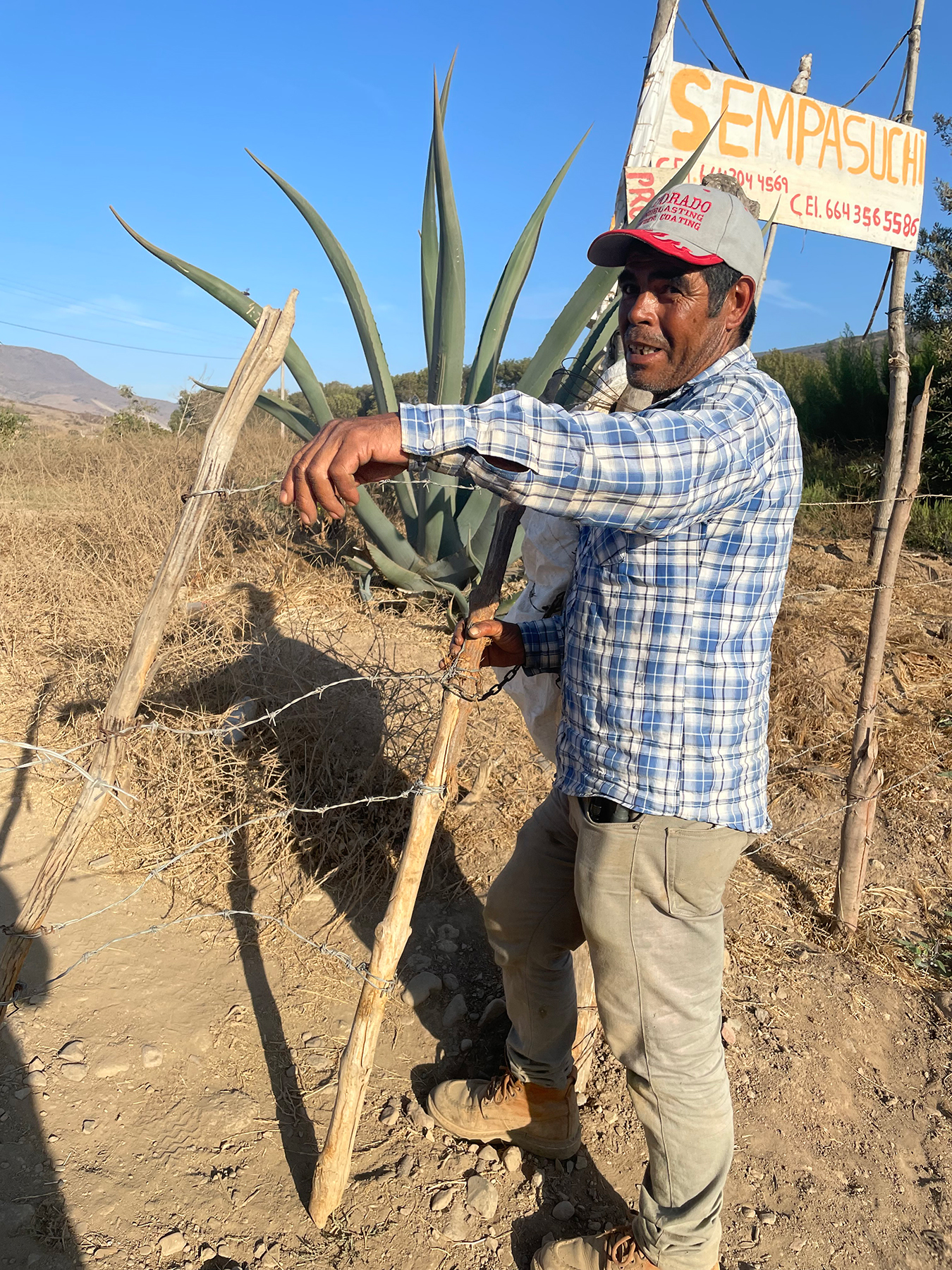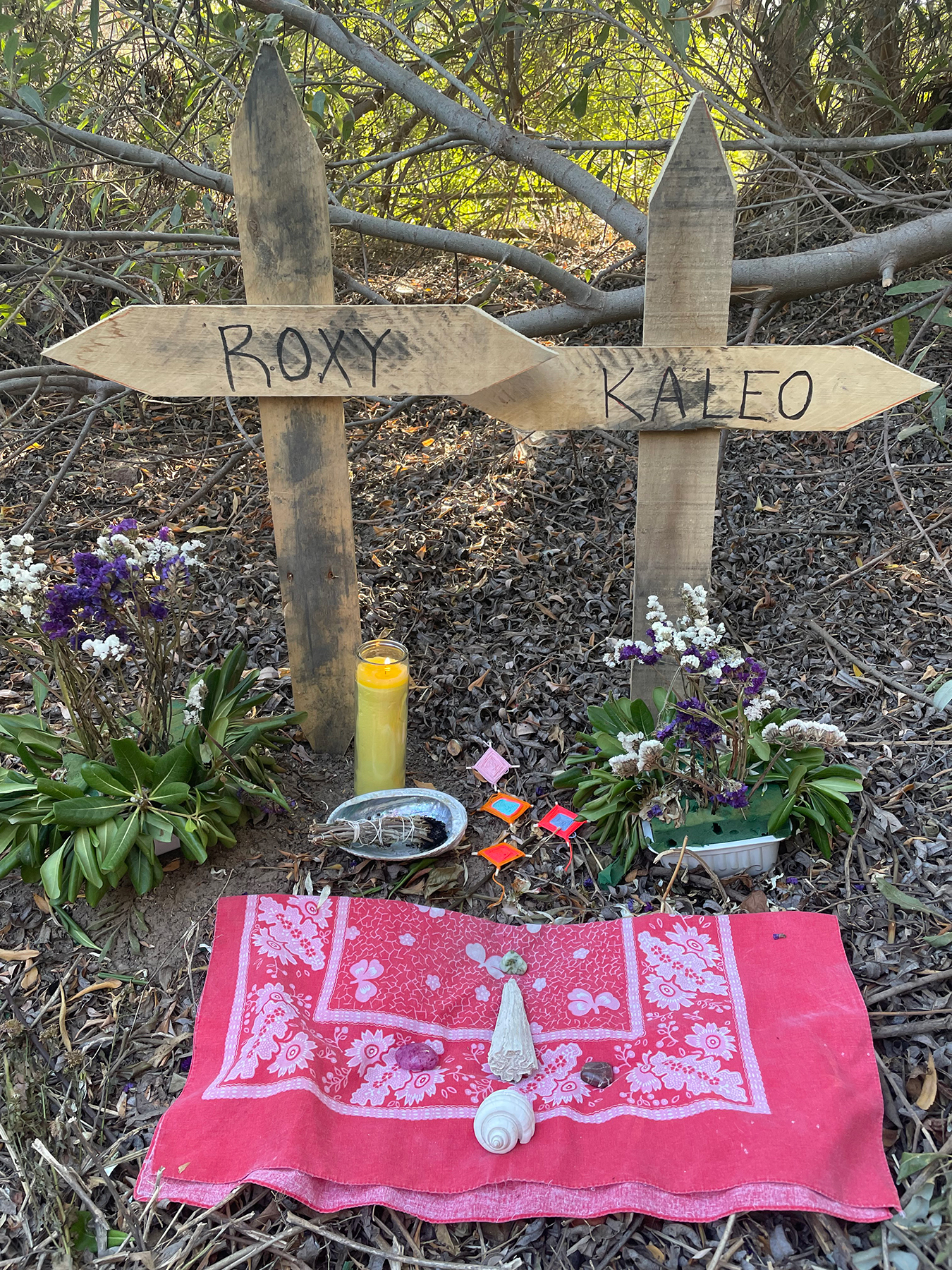QAnon’s Deadly Price
The sun had only just risen over Rosarito, Mexico, on August 9th when a neighbor told Roberto Salinas Ramirez about the blood spattered across the dry creek outside his small pink home. Ramirez, 47, lives on a farm next to fields of tomatoes and lettuce, in full view of the mesa-colored Cerro el Coronel, the area’s largest mountain. It’s a quiet place, removed from the tourists who go to the oceanside restaurants and strip clubs in nearby Tijuana. Ramirez hadn’t heard anything the night before, but the neighbor looked shaken. So he went out with his son’s dog, a white mutt named Kobe, to investigate.
Ramirez unlatched the fence — four strands of barbed wire wrapped around wooden stakes — and first saw the blood over a patch of dried-out brush and rocks. There was more on the bushes farther in, so he went deeper, but didn’t find anything. “My eyes were set over there,” he tells me as we walk along the brush, pointing to the northern swoop of the creek. “I figured I would see a big body.” He didn’t see anyone on first inspection, but soon, Kobe was barking at something about 65 feet in. “Maybe I was nervous, but I couldn’t figure out if I saw two feet or three. So I got a little closer, and I realized it was two little children,” he says.
There they were, Kaleo, two, and Roxy, 10 months, hidden under the leaves of a willow shrub, their small, pale bodies lying on their sides, backs together, naked save for diapers.
This is the wreckage that Santa Barbara, California, surf instructor Matthew Taylor Coleman, the father of these two children, admitted to leaving behind in one of the most inexplicable and gruesome crimes in recent memory. Coleman, 40, was a staple of his community, an evangelical Christian who ran a surfing school and tutored Spanish, the kind of person who was known to comfort those who’d lost their own children. But when he was arrested at the U.S.-Mexico border just hours after the bodies were found, another side of him emerged. According to a federal criminal complaint, Coleman told an FBI agent he’d recently been “enlightened” by QAnon — the satanic panic that helped fuel the January 6th insurrection on the U.S. Capitol. His children, he said, had “serpent DNA” they’d inherited from his wife, and he was “saving the world from monsters.”
Coleman has since pleaded not guilty to two counts of foreign first-degree murder, setting up the deaths of these two children — and the basis for Coleman’s beliefs — to the scrutiny of prosecutors and internet conspiracy theorists alike. Already, online trolls have sought to undermine the story about Coleman’s history as a false flag, a planted piece of fake news by the powers that be to discredit a movement. But deeper concerns lay ahead. A third of Americans had once been open to believing that cabals of devil-worshipping elites, aided by “deep state” government officials, steal children and kill them for their blood, the basis of QAnon’s belief system — that has some eerie similarities to the crimes Coleman stands accused of.
Now, looming over Coleman’s prosecution is a bigger question of QAnon’s place in the American political order. Has the U.S. populace drifted so far from reality that QAnon is just another ideology, and Coleman was a true Q believer fully in command of his faculties? Or would only the criminally insane believe in the conspiracy so deeply that they’d act on it?
There should be a word for cities like Santa Barbara, these good-vibes enclaves with all the trappings of wealth — high art, second homes, a sense of outdoorsyness — but removed from the industries that created it. “The American Riviera” appears on the city’s tourist literature, and its outskirts are miles of beaches where surfers wade for hours and plovers peck for food in the sand. About two hours up the coast from LAX, Santa Barbara residents boast that the city of just more than 91,000 people is a welcoming community where everyone knows everyone, and it just so happens that Oprah Winfrey, Ellen DeGeneres, and Prince Harry and Megan Markle live one town over. But it’s also a place with a dark undercurrent. The Ku Klux Klan burned crosses to keep Black residents out of white parts of town in the 1950s, and a restaurant called Sambo’s — which had displayed racist cartoon characters as decorations — only agreed to change its name last year. In 2014, a self-described incel killed six people and injured 14 more after online men’s rights groups radicalized his frustration over being single into a murderous rage.

Coleman in 2016
Coleman was born here in 1981. He’s the first biological child of John, owner of a carpet-cleaning business, and Lori, a potter; Michael, his older brother by about two years, was adopted. Known as Matty, Coleman had light shaggy hair and a wide smile that revealed a slight overbite — a trait inherited from his father. By most outside appearances, he had an idyllic childhood, with a home that was a regular spot for neighborhood kids to play Nintendo or climb up the treehouse out back. When they got older, they’d attempt ollies off a homemade skateboard ramp. “He always was popular, but he didn’t act like it. He acted very — I don’t know, the opposite of arrogant, he was humble,” a childhood friend, Adrian, tells me. (Like most people in this story, Adrian didn’t want his full name used, out of concern of social reprisal.) Adrian looked up to him as a role model, and recounted how, when they were seven or eight, Coleman helped him when he got stuck climbing the rickety ladder into the treehouse: “He wasn’t just making fun of me because I was stuck. He was like, ‘Oh, no, I can’t have Adrian be scared. Can’t have him be in danger.’ ”
Coleman’s biography, up until this August, is one that sticks out only for being so unremarkable. He surfed, he liked dirt bikes, he made friends with girls easily. He was sensitive; he told a friend he’d witnessed an act of animal abuse as a boy, and it had affected him deeply. At one point in his early teens, he seemed to push boundaries further than some other kids his age. Coleman was with another boy who tried to corner a girl in a room, in what the girl said was an act of “sexual harassment,” according to a friend told directly about the incident. While the source says the other boy was expelled, Coleman got off with writing an apology letter. When he got to high school, though, his interest in Christianity grew more intense, and he would routinely carry around a Bible in which he’d scribble in the margins. Not one of more than a dozen people who knew him during the next three decades could recall any violent or disturbing incidents. In his high school yearbook, his parents bought an ad. There are two pictures of him, one as a boy holding a stuffed monkey, the other nearer to graduation, with gelled hair and iced tips. “Matt, your name means Gift of God,” the ad reads. “We thank God for the gift of you.”
While Coleman grew up religious, Adrian recalled little, if any, Christian iconography in the house. (When I visited the home in September, there was a cross and a small poster with the word faith on it hanging in the living room, near pictures of Matt and Michael. John, their father, declined to comment.) Still, Matt’s faith seems to have become the central axis of his life. He went to an evangelical college in San Diego, where he surfed and went on missionary trips to Spain and Mexico. As he got older, he hopped from church to church, mentoring local kids in the Bible or helping with homework. “I always viewed him as just wanting to care for the kids. He just loved people and wanted to help people,” says Shoreline Community Church assistant pastor Jon Harris, who knew him for about eight years.
Even though friends recall him wanting a family and children back when he was a kid, it wasn’t until January 8th, 2017, that 36-year-old Coleman married Abby Droogsma, a Texas woman five years his junior, who he met through a church group. “It seemed fast,” Harris remembers of their courtship. “He desired it and wanted it. He was stoked to be with her.” Her social media shows she was into CrossFit and Christianity, a proud aunt to her siblings’ newborns, and for a few months, wrapped up in a multilevel marketing company that sold weight-loss powders and promises to get people out of debt. In one 2013 post about what she desired in a future husband, her interests were broad: “food (Mexican), music, alcohol,” the list starts. “Must hate the sin and love the sinner :)”
Soon after marrying, they rented a small blue ranch house off a cul-de-sac near Hendry’s Beach, a popular Santa Barbara surfing site. When I visited, a piece of wood covered a window, and another renter, who lived in the garage, refused to talk. In 2019, their son, Kaleo, was born. To the neighbors, Abby was warmer, quicker to chat, known to bring banana bread or trade gardening tips. After Roxy was born in late 2020, Abby would take the two kids out for walks and stop at a neighbor’s garden to play with the statues of flamingos, seals, raccoons, and other woodland creatures. “Every time she walked by with her kids, she would stop and talk, either coming or going,” says Richard, a neighbor across the street. As the adults chatted, the kids would play with the menagerie of animal statues on his front lawn and eat loquats, an apricot-like fruit, from his garden. “She was a good mom to those kids. She really watched over them, took care of them,” he says.
Whatever strains that may have come out during the pandemic weren’t clear to outside observers. Coleman’s surfing school, Lovewater — where Abby also sometimes worked — appeared to be doing better than ever. “He was the go-to person to do any kind of surf lessons in Santa Barbara County,” says Jethro Acosta, owner of the local dive shop Blue-water Hunter, who last saw Coleman just a few days before the killings. “I’m sure he was busy. And of course, after the whole Covid thing, he was probably triple-busy, because every parent is like, ‘What am I going to do with my kids? Oh, let’s call Matt.’ ”
There’s no formula for a filicide, no algorithm that leads a father to stab his children to death. QAnon, the Illuminati, lizard people — there are millions who believe theories like these and don’t commit crimes. By the time Coleman is said to have abducted and killed his children, nearly a year and a half into the Covid-19 pandemic, these ideas were part of his world. Abby, for one, followed anti-vaxxer groups on Facebook that post lies about the danger of vaccines. A close member of her family spread the “Plandemic” video, which falsely claims the coronavirus outbreak was a political conspiracy, and stories claiming that “Satan has found a home in Dem party leadership.”

It was just after dawn on August 9th, 2021, when Roberto Salinas Ramirez found the bodies of Roxy and Kaleo near his home in Rosarito, Mexico. His son’s dog was barking at something several yards out: “I realized it was two little children.”
Kevin Dugan
Coleman’s own posts look ominous in retrospect, using language borrowed from Q-Anon’s “Great Awakening” — the idea that Donald Trump would make mass arrests of child abusers and usher in a new era — to describe the birth of his daughter last year. “While waiting for her to come, I kept feeling this sense that she was going to be born at a very pivotal time in history, and that she would represent a dawn, or even awakening, to years of great blessing for our family and nation,” he wrote in an Instagram post since taken down. For Coleman, these darker undercurrents that had apparently taken ahold of him weren’t visible in his day-to-day life. Friends have tried to reconcile the person they thought they knew with the man on the nightly news, and still come up short, relying on half-remembered stories to make sense of the senseless. For his part, Coleman remains in federal custody, and his lawyer didn’t respond to questions sent by Rolling Stone.
Still, Coleman is a case study in how enmeshed QAnon has become into the fabric of American life during the pandemic — and how it can be more insidious than other kinds of conspiracies. “QAnon is really interesting because it serves as a master conspiracy-theory belief into which lots of other beliefs can feed,” says Philip Corlett, an associate professor at Yale University’s Department of Psychology, and an expert on paranoia and conspiracy theories. The conspiracy’s adherents easily incorporate related theories, like the anti-Semitic belief that elites are secretly lizard people from space, or that 9/11 was an inside job, because of how wide-ranging they are, he says. It’s also spurred a growing number of murders. Earlier this year, one Kentucky woman allegedly killed a man who was giving her legal advice, after believing he had joined forces with the government in a custody battle; in 2020, a Q-obsessed Staten Island man was charged with killing a reputed Gambino-family crime boss to reportedly “save the American way of life.” And in a case that more closely resembles Coleman’s, one California mother admitted to drowning her three children because she felt powerless to stop them from being sex-trafficking victims.
Part of what has made QAnon and other all-encompassing conspiracies so hard to pin down is that elements of them have long been widespread. “Calling something a delusion versus a conspiracy theory is a normative claim,” Corlett says. “You can find people who have as many weird beliefs as patients with schizophrenia, and who endorse them with a similar degree of conviction, but it’s very rare to find a person who is deeply into conspiracy theories who is as distressed by them as patients with schizophrenia.”
In Santa Barbara, where evangelical Christians make up a small but influential minority, QAnon has been spreading among the faithful. “It’s everywhere,” Pastor Harris says. But it’s not just a local phenomenon. QAnon has had a hold on white evangelical communities, in part because of its apocalyptic message, and the focus on Trump as a messianic figure who will usher in a new era, says Dr. Jason A. Springs, a professor of religion at the University of Notre Dame. “QAnon is a conspiracy theory that really is, in its contours, tailor-made to attract certain tendencies in white evangelicalism,” he says. He also believes the marriage between the Christian right and Republican politics — particularly the grievances about the shrinking white, Christian population — made it propulsive in the past few years: “The fact that the QAnon conspiracy theories and white evangelicalism are infused with Republicanism, the fact that Donald Trump is a Republican president — and he is so extremely brash and tries to fight against political norms of propriety — it just ramps up the attraction.”
In the wake of the killings, there has been a sense of reckoning, with pastors at some of the more conservative churches coming out in force against QAnon. “It’s a betrayal of God’s goodness, and God’s hope, and God’s hope for families,” Pastor Tommy Schneider of the Calvary Chapel Santa Barbara said in a sermon after Coleman was arrested.
But attitudes toward these conspiracy theories — maybe because they are so endemic among evangelicals — were sometimes equivocal. “I’ve talked with people about conspiracy theories and things like that, but whether it’s a conspiracy theory or not, it’s ultimately what somebody wants to believe, or believes to be true,” Harris said. “I have friends that are conspiracy theorists of the military jets that fly over with the chemtrails. That’s true to them. Whether that’s true to me, it’s neither here nor there.”

Ramirez has since erected a memorial.
Kevin Dugan
Coleman awaits trial at an undisclosed federal prison in Southern California. As of publication, his only public statements since his arrest have been rote answers to a judge, affirming procedural questions about understanding the charges against him, entering his plea. While he has reportedly undergone a psychiatric exam, it’s not clear if he will use insanity as a defense. If he does, it would be a significant challenge for his legal team, says Heather Cucolo, co-owner and partner at Mental Disability Law and Policy Associates, and a New York Law School professor. Standing in the way is the Insanity Defense Reform Act, a Reagan-era law that restricted a federal insanity defense to those with “severe” mental illness, after a jury found John Hinckley Jr. not guilty of attempting to assassinate the president by reason of insanity. “The purpose was to make it significantly more difficult to get a verdict of not guilty by reason of insanity,” Cucolo says.
The set of allegations in the court documents “makes you think about the kind of classic mentally ill parent who kills their child,” says Dr. Ziv Cohen, a forensic psychologist who has focused on conspiracy theories. “But it’s also possible he does not have a severe mental illness, and he just became so wrapped up in conspiratorial thinking that he appeared like a psychotic person, but he wasn’t. He was really just wrapped up in conspiratorial beliefs and acted on that.”
Working against Coleman is an apparent admission in the federal complaint. “They asked him straight out, ‘Did you know what you did was wrong?’ He said yes,” Cucolo says. “It would seem that the cards are stacked against him.”
Even with his admission, however, there are still outstanding questions about what actually happened on the Mexican ranch that night. Ramirez, the man who found the bodies, says he called 911 around 7:30 that morning, and told authorities that he’d found two American children — he knew because they were so blond. Roxy and Kaleo had bruising on their faces, he says, and each had a single stab wound in their backs about “this size” — making a circle with his forefinger and thumb — the diameter of a bloody stake he found nearby, torn from the barbed-wire fence.
Official reports from Mexican and U.S. officials not only contradict each other, but also Ramirez’s account. According to the attorney general of Baja California in Mexico, Roxy was stabbed 12 times in the chest, while Kaleo was stabbed 17 times. The FBI doesn’t enumerate the stab wounds, but says that Coleman admitted to “using a spear-fishing gun, piercing [Roxy] in the heart.” The complaint is also unclear on whether Coleman used the same method to kill his son, but says that he “described that he had to move the spear around [to kill Kaleo], thereby cutting his hand in the process.” Ramirez also believes they were naked when they were killed, and says he was told later by Mexican authorities that the clothes didn’t have blood on them — contradicting the FBI complaint saying that Coleman admitted to throwing away “bloody clothes.”
It’s also unclear what happened the night of the alleged abduction. According to the complaint, after Coleman took the two kids in his Mercedes Sprinter van on August 7th, Abby called 911 to say she was concerned he’d left for an unknown destination without a car seat for their youngest, and wasn’t answering texts — but said that she wasn’t worried about their safety. (In another apparent contradiction, a surveillance still from the hotel where they stayed shows Coleman holding a car seat that appears to be too small for Kaleo.) Neighbors tell me they didn’t hear any fighting or anything else unusual that night, and Abby said as much during the call with police. The next day, she followed up with the Santa Barbara Police Department and an officer came to her home, where they used the Find My iPhone app to locate his last known location — a mall in Rosarito, Mexico. The SBPD won’t release the recording of the 911 call, or even the time or location of the calls, citing the ongoing investigation. The DOJ refused to answer questions about the case. Abby, for her part, didn’t return a request for comment. Her family has since raised more than $113,000 in a GoFundMe drive.
After the news about Coleman’s arrest first broke, many of the largest right-wing news outlets have opted not to cover the case, or downplayed Coleman’s belief in QAnon. While the conspiracy’s die-hards tend to incorporate contravening facts as proof of their beliefs, the blackout is also a missed opportunity for a larger reevaluation of the QAnon movement. “So long as Trumpism is there to fuel it, and there are people benefiting from this politically and religiously, I don’t think we’re close to the end,” Springs says. “Insofar as white evangelicals hope to deal with this, they need to come to terms with some of the tendencies that have made this affinity and connection between evangelicalism and the QAnon conspiracy so fruitful.”
Ramirez says he couldn’t sleep for two weeks after he found the bodies. He’s since put up crosses in the ground where he found Roxy and Kaleo, their names written in black marker, and is finally able to sleep. He’s planning on laying cement over the area to create a permanent memorial, in case the family ever wants to see the site, though only reporters and authorities have visited.
“It was the saddest day of my life,” he says of finding the children’s bodies. “That bastard. Why didn’t he just leave them with me? I would have taken them. Even if they were just naked, I would have taken them, without anything.”


